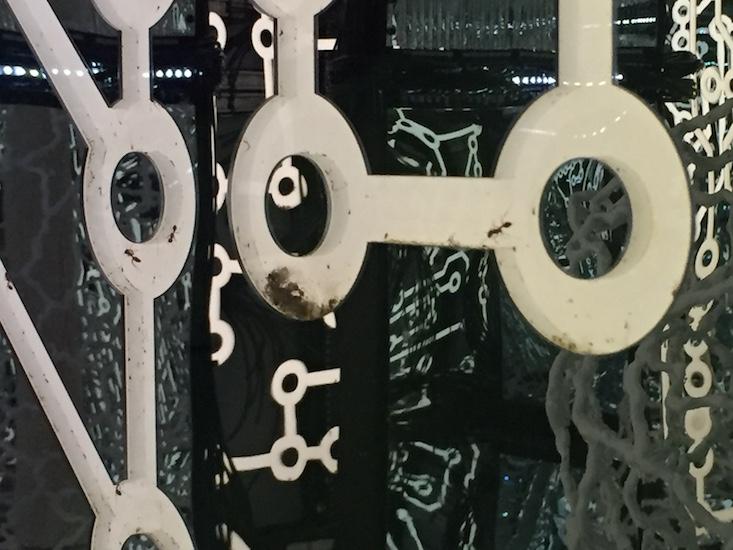
Right now, at the Guggenheim Museum in New York City, there are lots of dead ants in the glass corridors of one of Anicka Yi’s biosphere-like dioramas. The shared nest looks like an oversized circuit board comprised of mirrors and glass tubes the ants crawl through—a metaphor for the information highway. The carpenter ants toss their dead into large piles in bulbous cul-de-sacs as if they were cemeteries. After two or three days, a dead ant emits oleic acid, which signals to other ants that the corpse needs to be disposed, usually outside the nest. This death smell, comprised of fatty acids released from cells, evolved over millions of years to reduce the risks of bacteria contaminating the colony and spreading disease. Like most organisms, humans can recognize death by smell, too, and communicate via scent.
If bacteria, ants, and humans all communicate this way, is it possible for these three species to communicate, via scent, with each other? That seems to be one of the questions Yi wants us to mull over as we take in her new installation, “Life is Cheap,” on view through July 5th. An aroma Yi calls “Immigrant Caucus,” created with compounds derived from ants of an undisclosed origin and multiple Asian-American women based in New York’s Chinatown and Koreatown, not only fills the exhibition air but is also piped into the ants’ biosphere. “Yi posits the scent as a drug that manipulates perception,” the Guggenheim website states, “offering humans the potential to experience the installation with a new, hybridized perspective.”
With as much bacterial DNA as human DNA, we had to question our nature.
It’s as if she wants to help us adopt an ant’s perspective, where odor—not light—is the primary source of information. Researchers of ant chemosensory biology, such as Laurence Zwiebel and his colleagues at Vanderbilt, have found that chemical communication plays a huge role in ant behavior, dictating their social status within their complex social organization. Ants seem to be able to sense the same odorants that humans can, but scientists have found that ants differ greatly in their sensitivity to concentrations. With more odorant receptors than humans, they can detect minute amounts of different chemicals and distinguish between odor compounds that differ only slightly. Pheromones both identify them as individuals and nest-fellows. Ants use their antennae, which house their olfactory organs, to sniff the identifying hydrocarbon chemicals on each other’s outer shell when they meet. If an ant were to venture into one colony carrying the body odor of another, it is likely it would be attacked.
We have approximately 400 scent receptors that detect a trillion different odors, and there is no shortage of biological and social odors produced by human bodies for us to smell. These chemical signals aid in recognizing people, including their sex, age, and genetic makeup, as well as conveying the person’s diet, hygiene, and bacteria community.
The signals aren’t merely or rigidly biological. The idiosyncrasies of our social and cultural lives significantly influences our conscious and unconscious responses to the smells of others and our behaviors toward them. Some human responses to odors are hard-wired; however, negative impressions are also influenced by prevailing social paradigms. Human smell associations, conscious and unconscious, unite and divide people, suppress some and uplift others. Around the world, anti-immigrant bias, discrimination, and racism can be linked to, among other things, differences in smell—perhaps as part of an evolved disease-avoidance mechanism—not unlike the ants who attack those from other colonies.
In another diorama, the walls and sculptural forms are coated with agar to enable the growth of bacteria collected from New York’s Chinatown and Koreatown. Arrays of little creatures, the Earth’s oldest, reproduce on their own, and now live in the installation, visible to the naked eye as blotchy patterns. The bacteria, too, communicate via chemical signals, a process called quorum sensing, which allows their community to coordinate behavior. This synchrony enables them to act like a multicellular organism affecting other life forms, such as human hosts. It is by quorum sensing, for example, that bacteria have the capacity to develop antibiotic resistance.
The next question the installation seems to ask is: To what extent are human decisions and attitudes, as opposed to those of the ant, shaped by biochemicals—the olfactorial and, by extension, the microbial world?
When it comes to bacteria and the human body, you may be astounded to learn that microbiologists have shown humans to be comprised of as many, if not more, bacterial cells than human cells. With as much bacterial DNA as human DNA, we had to question our nature. The bacteria are communicating with us in ways we are just beginning to understand.
Since the early 1990s for instance, there has been a rapid accumulation of evidence on cross- and inter-kingdom signaling, chemical communication shared by and conducted between animals, insects and bacteria. It used to be thought that quorum sensing was a way for bacteria to coordinate their gene expression within a population. But, as a 2008 review paper argues, it’s “not restricted to bacterial cell-to-cell communication”—it also “allows communication between microorganisms and their hosts.” This helped us understand the roles bacteria have played in our evolution and how much we rely on them in our lives.
Yi’s work, with its fusion of aesthetics, can ultimately lead to a better understanding of nature. And perhaps there’s an ideological function, too—to clear up some misunderstandings and psychologically dissolve boundaries between species that were, in a sense, never there.
Gayil Nalls, Ph.D. is an interdisciplinary artist, therorist and pioneer of olfactory art. Follow her on Twitter @olfacticinkblot and @themassinglab.
WATCH: The neuroscientist Lisa Feldman Barrett says we can regulate each other’s nervous systems with words.

Anicka Yi won the 2016 Hugo Boss Prize for “outstanding achievement in contemporary art.” The prize is administered by the Guggenheim Museum Foundation, and includes a cash prize and a solo exhibition at the Solomon R. Guggenheim Museum, New York.






























